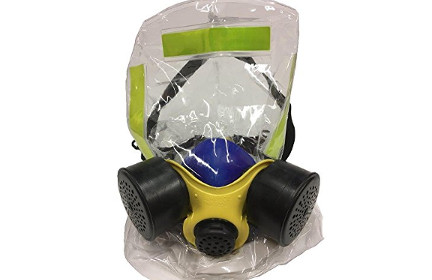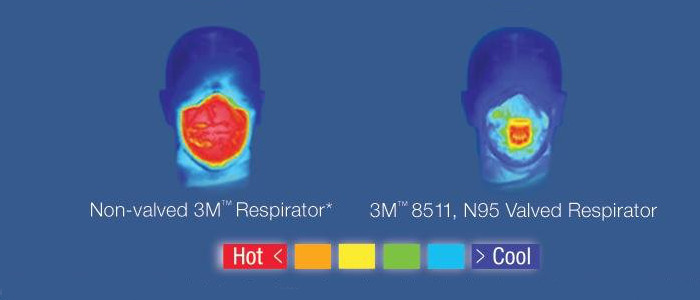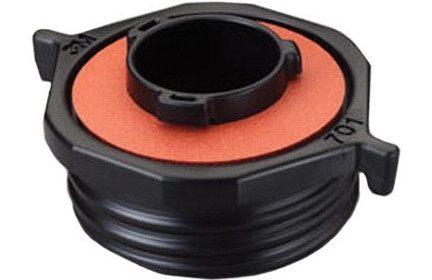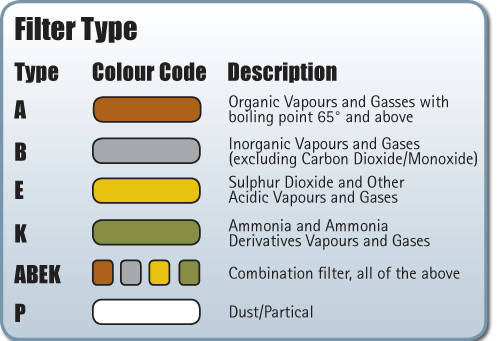The best masks for emergencies are respirators because they prevent bad stuff from getting into your respiratory system. Bandanas, dust masks, and surgical masks are not respirators and are not something you should rely on in emergencies!
COVID editor’s note January 24 2020: It’s basically impossible for a consumer to find a proper respirator after the initial panic buying and severe lack of government/hospital preparation. But in this case you can still make a meaningful difference protecting yourself and others with simple face masks. Here’s a collection of DIY mask instructions, tips on safely putting on and taking off your mask, and you can follow COVID updates and analysis here. Don’t forget to protect your eyes, too, and that exhalation valves on masks means you could be spreading the virus via blowing it out of your mask.
Respirators have a nice cost/weight/volume to benefit ratio, especially the smaller disposable ones, and should be in every emergency kit.
Yet many preppers either overlook them entirely, think N95 is the answer to everything, or buy a cheap gas mask while believing they can bug out to Chernobyl.
There are common but serious misunderstandings about lingo, how they work, and what types of masks work well for emergencies (rather than masks meant for painting or sawing).
For example, the masks you see many people wear during daily life in Asia do almost nothing to protect you from external threats like disease — they are designed to protect other people from you.
When people refer to “gas masks”, those are respirators. So are the disposable N95/P100 ones that form a tight seal around your nose and mouth, or the half-face versions commonly used in industrial or construction settings.
During the 2017 wildfires that choked major California cities with smoke, local stores completely sold out as people rushed in to buy masks. So you can’t depend on finding respirator masks easily when you need them at the last minute. Buy some today!
Most important tips for emergency respirators:
- Most people should have a mix of cheap disposables and a half-face model in their emergency bags, and possibly a CBRN- or NBC-rated gas mask at home.
- Start with the disposables and work your way up. A nuclear gas mask should not be one of your first purchases, if you ever buy one at all.
- Respirators are temporary solutions to help you escape danger. You will not be spending days traveling the wastelands wearing just a gas mask.
- There is a wide range of gas masks and respirators. They are not equal. What you buy matters.
- Masks cannot protect you from everything in all cases. It’s an 80-20 game.
- Do not buy surplus masks or clones from cheap countries.
- You can run through 1-3 filters in a single day. Stock up.
- Pay attention to mask fit, proper storage and care, proper use, and respecting expiration dates.
- Children and those with facial hair don’t have a lot of good options, but we offer tips below.
To be honest, this article took a lot longer than expected, mostly due to the overwhelming amount of fraudulent garbage and grossly disorganized info on the internet.
Here are our top recommendations. Full details and background info are below the fold.
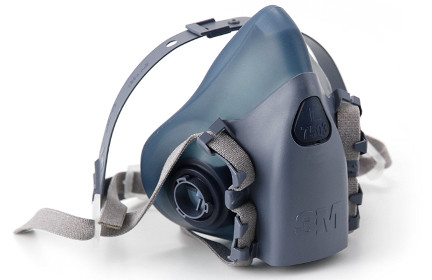
Industry-tested comfort:
3M 7500 Half Facepiece Respirator
We think the professional half face respirators are a great but too-often-overlooked choice for preppers. They’re not much more expensive than the disposables and take up about the same amount of room in your supplies and bags. Yet they provide better protection and comfort. We like the very popular 3M 7500 masks. When matched with the 3M 7093C P100 plus Nuisance Gas filter (they’re sometimes cheaper in bulk at Uline) or 3M 60926 Cartridge plus P100 Filter, you get the highest level of particulate filtration and relatively good protection against gases and vapors like chlorine and ammonia.
Best disposable:
3M 8293 P100 Disposable Particulate Respirator
Cheap and plentiful, the right disposable respirator is an easy way to protect yourself in the most likely emergencies (fires, pollution, illness, etc.). We like the 3M 8293 P100 and Honeywell Sperian P100 Saf-T-Fit because of their best-in-class protection against the widest range of threats. A cheaper but still great option is the 3M 8576 P95 Acid Gas.
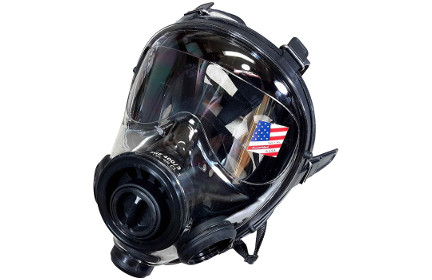
Best gas mask:
Mestel SGE 400/3 Gas Mask
There are fewer appropriate gas masks than you might expect. Among the few we trust with our lives, the Mestel SGE 400/3 is the best for most people. It’s rated for Nuclear, Biological, and Chemical threats, while its more expensive bigger brother, the CBRN-rated SGE 400/3 BB, can also handle particularly nasty threats like mustard gas. We dig deeper into CBRN vs. NBC, how to buy gas masks for sale, accessories, budget masks, and more further down the page.
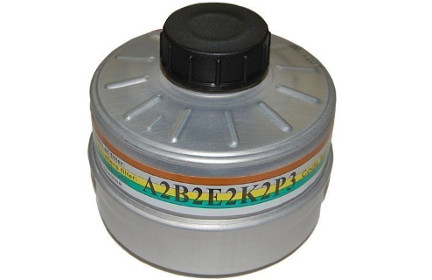
Best for gas masks:
Mestel 40mm CBRN Filter
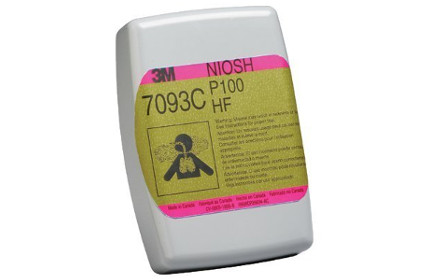
Slim combo for half masks:
3M 7093C Nuisance Gas Filter
Common sense prepping, straight to your inbox.
Get our free newsletter for great new articles and giveaways. 1-2 emails a month. 0% spam.
- Why you should trust us
- Basics of emergency respirator masks
- Types of respirators and gas masks
- Which types of respirators and gas masks protect the best?
- What do N95 and P100 respirator mask ratings mean?
- How do gas masks and respirators work?
- What threats do respirators protect against?
- Importance of mask fit
- Best disposable respirator masks
- Best half face respirators and filter cartridges
- How to buy a gas mask or full respirator
- NBC vs. CBRN ratings
- How we picked the best gas mask for sale
- Best CBRN NBC gas masks when SHTF
- Best gas mask filters
- Alternatives and emergency escape hoods
Why you should trust us
We spent 43 hours researching, reviewing, and speaking with experts for this article. Experts included active HAZMAT / CBRN first response professionals and military instructors. We dug into and double checked the technical specs and cross-referenced any product recommendations with the Centers for Disease Control’s NIOSH approved product list. And we spoke with product specialists at each company (or main approved distributor).
“This is the best article I have seen on this subject for preppers. Great, very detailed, in-depth post!” – Admin of Reddit /Preppers.
Basics of emergency respirator masks
In common lingo you’ll often hear “masks”, “respirator masks”, and “gas masks” used interchangeably. But those labels are often used incorrectly.
The word “mask” is misleading. Masks are simply barriers. Surgical masks are designed to shield a patient from a doctor sneezing, for example. It’s a little confusing because a gas mask is actually a respirator and much more effective than most other masks, but the lingo has stuck since World War I.
Respirators are what people actually mean when referring to emergency gear. They protect your respiratory system by filtering bad stuff out of the air as you breathe.
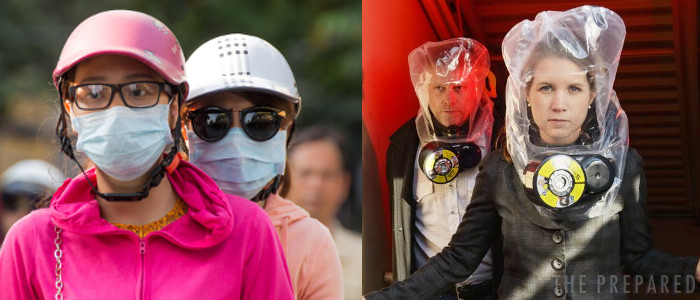
Types of masks people refer to in conversation:
- Dust masks. Cheap masks used when people are doing construction, like cutting wood.
- Surgical masks (aka procedure masks). They do not protect your lungs. Instead, they prevent any particulates from the wearer’s mouth and nose from spreading outward, like a doctor sneezing during surgery, or blood splashes from landing in the wearer’s mouth.
- Respirators. Technically “gas masks” are also respirators, but in common lingo people usually mean the disposable N95 types or construction crew types that form a tight seal around your mouth and nose.
- Escape hoods (aka fume hoods, smoke hoods). Cheaper, single-use version of a gas mask, but specifically for sudden “I need to escape this burning building!” types of emergencies.
- Gas masks. People use this label for all kinds of gear, even though it technically only means respirators that protect against gases.
- CBA/RCA gas masks. Rated for Riot Control Agents like pepper spray.
- NBC gas masks. Rated for Nuclear, Biological, and Chemical threats.
- CBRN gas masks (aka riot masks). Basically an NBC mask plus extra protection against “terrorist” threats like dirty bombs.
Types of respirators and gas masks
There are four main characteristics:
- Passive vs. Powered. Passive means your breathing motion draws air in through a filter. Powered respirators use batteries and fans to suck air in, which makes it easier to breath. But we ignore the powered kinds because they don’t work without power.
- Air Purifying vs. Air Supplying. Air Purifying simply filters the outside air as you breathe in. Air Supplying comes from tanks, called SCBA, which pro firefighters and HAZMAT teams use. We ignore the air supplying kinds.
- Form factor. Does it cover half your face, is it a full hood, etc.
- Threat protection. Varies from spray paint and sawdust to disease and fallout.
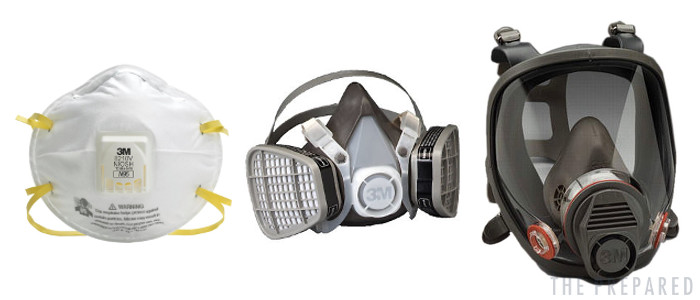
We focus on the passive Air Purifying Respirators (APRs), which come in different forms:
- Filtering Facepiece Respirator (the disposable N95 types)
- Half Facepiece Respirator
- Full Facepiece Respirator
- Powered Air-Purifying Respirator (PAPR), which are disqualified due to power needs
Which types of respirators and gas masks protect the best?
The NIOSH calculates a “protection factor” for various systems, which is a numerical score representing how effective it is:
- SCBA = 10,000 (since it uses clean air in a tank)
- PAPR = 50-100 (depending on the mask it’s paired with)
- Full Face APRs = 50
- Half Face APRs = 10
- Disposable APRs = 5
Even though a disposable, half, and full face masks might have the same particulate filter rating (like P100), NIOSH doesn’t assume they protect the same in real life. This is because many people wear masks incorrectly, there’s a gap in the seal due to facial hair, the full mask offers eye protection, and so on.
Disposable respirator masks, like the common N95 or P100 types, are the minimal acceptable protection in common emergencies. They filter out particles such as floating burnt pieces of plants and buildings, dust, and bacteria. But disposable respirator masks do not protect against gases and (most) vapors.
It’s logical that half face respirators do a better job than their disposable alternatives. And that full face respirators do a better job than half faces because of the larger face seal and eye protection.
Dust masks, surgical masks, and bandanas are not good enough for emergencies
To be very clear: Surgical or dust masks — the kind you typically find in hospitals, pharmacies, and hardware stores — WILL NOT HELP in emergencies.
According to the CDC, “Surgical masks are not designed to capture a large percentage of small particles and will not prevent the wearer from breathing in airborne particles such as contained in wildland smoke. Covering the mouth with a (damp or dry) bandana, handkerchief, or tissue also will not prevent the wearer from breathing in airborne particles.”
They are designed to stop particles that are large enough to see with a naked eye, like saw dust. Or they’re designed to keep you from sneezing your cold virus onto other people.
They’re not designed for the kinds of emergencies you’re preparing for. Too much unfiltered air gets through, and they don’t screen out gases, ultrafine particles, etc. Such masks may even give you a false sense of security, increasing your risky behavior.
A government study showed that both wet and dry bandanas block as little as 3% of particulate matter. They simply don’t work.
What do N95 and P100 respirator mask ratings mean?
The CDC’s National Institute of Occupational Safety & Health (NIOSH) sets the standards and certifies personal protective equipment in the US.
The first letter refers to how oil resistant the mask is. The oil rating matters during emergencies because things like pepper spray can clog up your filters. The number refers to the percentage of particles filtered out by the mask.
In America:
| Rating | Oil resistance | Description (>0.3 micron particles) |
|---|---|---|
| N95 | Not oil resistant | Filters at least 95% of airborne particles |
| N99 | Not oil resistant | Filters at least 99% of airborne particles |
| N100 | Not oil resistant | Filters at least 99.97% of airborne particles |
| R95 | Oil resistant | Filters at least 95% of airborne particles |
| R99 | Oil resistant | Filters at least 99% of airborne particles |
| R100 | Oil resistant | Filters at least 99.97% of airborne particles |
| P95 | Oil proof | Filters at least 95% of airborne particles |
| P99 | Oil proof | Filters at least 99% of airborne particles |
| P100 | Oil proof | Filters at least 99.97% of airborne particles |
The most common is N95. N95 is often used in healthcare settings to protect against inhalation of infectious particles and P100 is used in manufacturing to protect against toxic dusts such as lead or asbestos.
In Europe, the rating levels work a little differently:
| Rating | Description |
|---|---|
| P1 | Filters at least 80% of airborne particles |
| P2 | Filters at least 94% of airborne particles |
| P3 | Filters at least 99.95% of airborne particles |
The EU also uses the letters FFP for disposable respirators and just P for the half- and full-mask respirators. So a US N95 disposable is equal to an EU FFP2.
How do gas masks and respirators work?
Without getting too sciencey, think of the basic difference between threats as whether the threat is a particle or a gas.
Particles are tangible, physical things floating in the air. Like dust, smoke and combusted debris from a fire, asbestos from a collapsed building, viruses and bacteria, and even tear gas (which is actually floating crystals, not a gas).
They’re filtered with very fine screens, measured down to below 1 micron. For reference, an average human hair is 75 microns wide. The N95 mask is rated such because it screens out 95% of particles that are 0.3 micron in size.
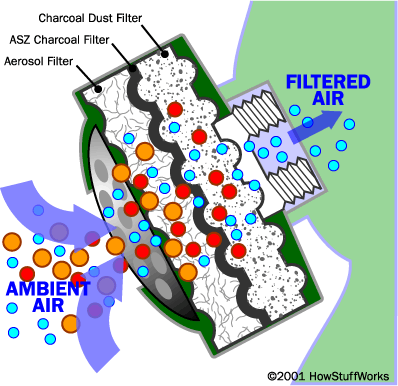
Gases are the trickier ones because they slip through even the most fine-grained screens. Which is why you can breathe air (a gas) through a particulate filter.
So instead of trying to block the gas, an absorbent — typically activated charcoal, a very porous form of carbon — attracts and soaks up the chemicals as they pass through.
Not every gas is naturally trapped by charcoal. Which is partly why some specific threats, like ammonia, are rated separately from umbrella categories like “inorganic vapors”.
What threats do respirators protect against?
While respirators are extremely valuable and you should definitely buy some, the overall feedback we’ve seen in our research among professional and legitimate sources (not the many factually challenged prepper sites) is that respirators really aren’t the silver bullet some people believe.
Respirators are designed to help you escape. You really shouldn’t pop one on and walk around carefree in a nuclear wasteland while scavenging for food all day.
We would love to give you a simple chart that says, “This type of mask protects against diseases!”
But it just doesn’t work that way. Yet, unfortunately, many websites give you false information for the sake of making those simple soundbite claims and selling a product.
Respirators simply can’t protect you from all threats, or even give you 100% protection against the threats they are officially approved for.
One reason is the wide range of particle sizes, even among one specific threat. Some bacteria are 0.2 micron in size, while others are 60!
For example, the influenza virus is typically spread by hitching a ride in water droplets expelled from an infected person’s mouth or nose. The virus itself is usually under 2.5 microns, but normally floats within droplets that are 5-10 microns. N95 masks will stop the vast majority of those droplets and virus particles.
But recent research found that some of the smaller flu viruses, which can get down to 0.1 micron, can stay suspended in the air for hours as the water around it evaporates. Those smallest flu particles could squeeze their way through a respirator filter.
Respirators are still a worthy line of defense, however, as a recent CDC study found that a properly-fitted N95 respirator mask blocks 99.6% of flu particles.
The common threats most civilians should worry about, in rough order of likelihood:
- Pollution
- Fires and smoke
- After natural disasters, like earthquakes
- Pandemics and day-to-day bacteria/virus
- Riot control agents (pepper spray, tear gas, CS, CN)
- Chemical spills, industrial auto and train accidents, etc.
- Volcanic ash
- Nuclear
- Biological or chemical attack
Top items that a certified respirator is usually tested against (and their common abbreviations):
- Ammonia (NH3)
- Arsine
- Asbestos
- Bacteria
- Benzene
- Bromine
- Carbon Tetrachloride (CCl4)
- Chlorine
- Chlorine Dioxide
- Chloropicrin (PS)
- Cyanogen Chloride (CK)
- Formaldehyde
- Hydrogen Chloride
- Hydrogen Cyanide (AC)
- Hydrogen Fluoride
- Hydrogen Sulfide
- Lewisite (L)
- Methylamine
- Mustard (HD)
- Particulates
- Phosgene (CG)
- Phosphine (PH3)
- Radioactive particulates
- Sarin (GB)
- Smoke
- Sulfur Dioxide
- Virus
- VX
NIOSH recognizes a total of 139 agents in their CBRN testing. If you really want to see all the different chemicals, gases, and vapors that are considered against respirators, see pages 15-122 of this 3M guide. Yes, that’s over 100 pages of chemicals — enjoy!
Pollution
It’s no joke — air pollution contributed to 6.1 million global deaths in 2016. Pollution is getting much worse and spreading from traditionally polluted countries like China and India to Western countries. United Airlines even cancelled some flights in 2017 because the air was so bad it was considered toxic to their employees.
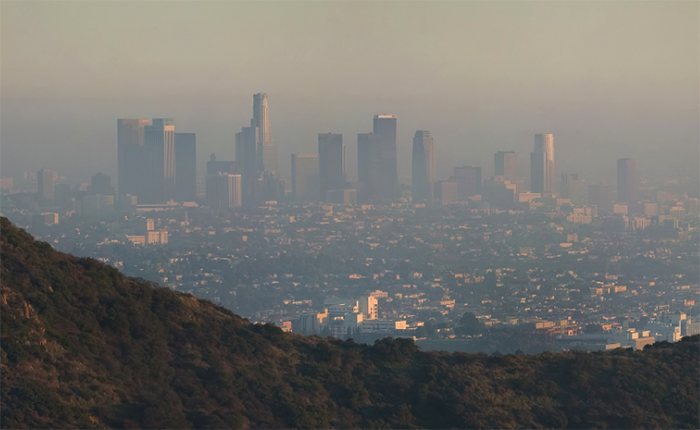
Air pollution is particularly risky for people with cardiovascular health issues, like high blood pressure and heart disease, people with lung issues, elderly, pregnant women, and children.
A recent study in Beijing showed that wearing respirators while walking in average air pollution prevented the typical rise in blood pressure and heart rate.
We are closely approaching a time where sudden “pollution storms” will make US and European cities almost unliveable for at least a few days at a time. Having proper respirators ahead of time will help you minimize the disruption.
Smoke and fire
In home, business, and wildfire situations, most people die from the smoke, not the fire.
A respirator won’t solve all the problems, like heat and lack of oxygen, but they can make a huge difference in whether you survive these common events.
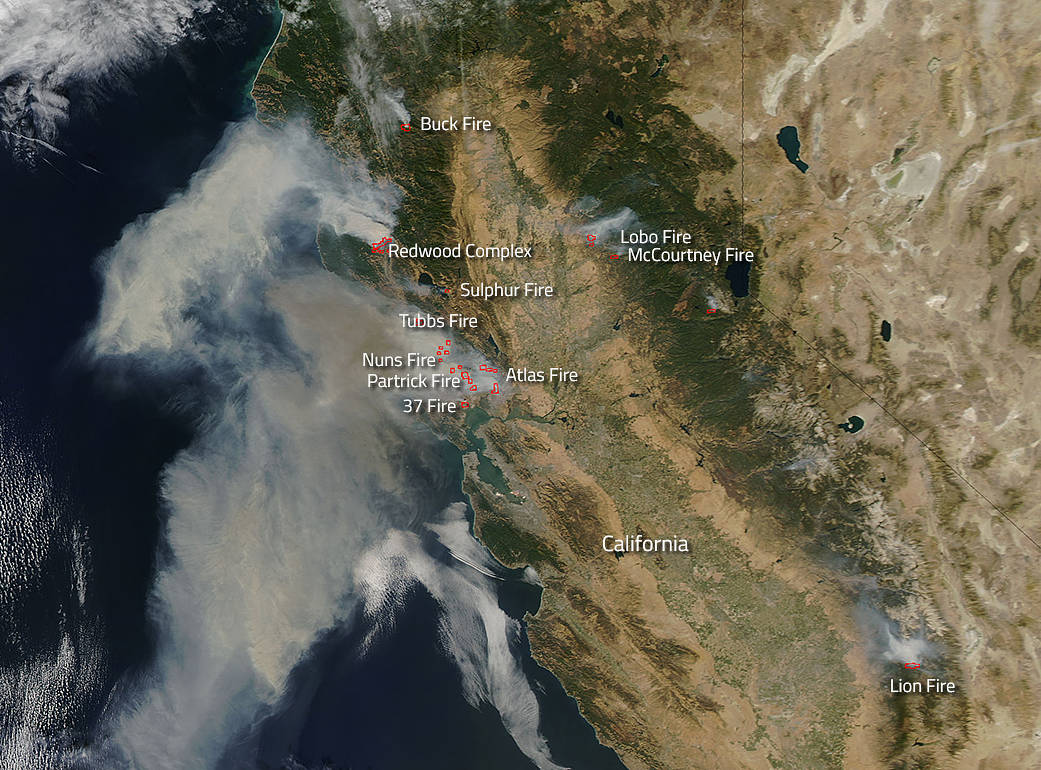
Or, as people in California learned in 2017, a respirator can help you go on with your life as a wildfire burns many miles away.
When fires burn, natural and manmade particulates (tiny pieces of burnt stuff) and chemicals (like chlorine) are released into the air. Some of the dangers are large enough to see, others are as tiny as light waves. The very fine particles found in common smoke can work their way down into the deepest recesses of your lungs.
Natural and man-made disasters
Earthquakes, tsunamis, hurricanes, and other destructive events (like a train derailment) can release all kinds of bad stuff in the air by knocking down buildings, creating industrial toxic leaks, and so on.
A relevant example is the 2001 World Trade Center attacks. There’s even a name for it: Ground Zero Respiratory Illness.
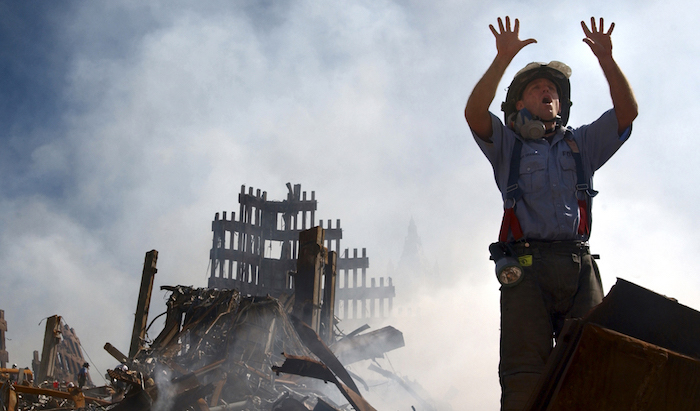
For five months after the attack, building materials, furniture, organic waste, etc. were floating all over the island.
Over 200 first responders have died so far due to toxic dust at WTC. Another 10,000 have had some form of illness.
Pandemics and common illnesses

There’s a theory among emergency management personnel about why governments continue to tell people to wear surgical masks during an outbreak, even though they know basic surgical masks protect other people from you, not the other way around.
It’s a simple reverse psychology trick. Since people take action to protect themselves, but are less likely to do it to protect others, governments tell people to wear masks — while letting people think it protects themselves — because if even 30% of people are prevented from unknowingly infecting others, that can be enough to turn the tide against the pandemic.
Although not 100% effective in all cases, a respirator can make a big difference. Both in normal illness, like the nasty 2018 flu season, and huge pandemics, like the 1918 Spanish Flu that killed 75 million people.
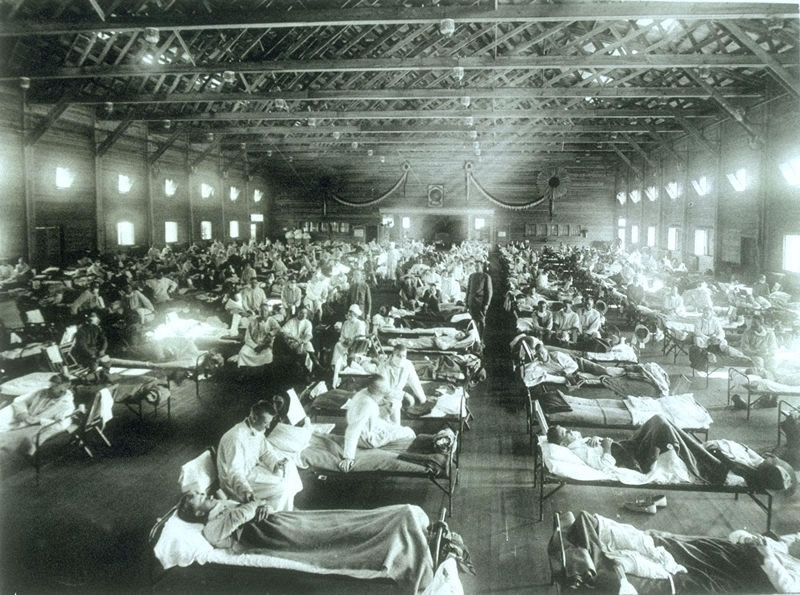
Many preppers worry about things like smallpox, influenza, tuberculosis, diphtheria, SARS, H1N1, Ebola, and Zika. But not everything is solved with respirators, since some diseases like Zika are spread through mosquitoes.
Many legitimate medical leaders are convinced that we’re in store for some seriously nasty pandemics in the next decades. One unexpected reason: Climate change is thawing areas that have been frozen for millions of years, unearthing bacteria and viruses our bodies (and medical systems) have no idea how to handle. See more about these risks in Rational Reasons Why People Are Preppers.
Riot Control Agents
Fun fact: Using tear gas is a war crime if used in a military setting. It was banned in the 1990s via the Chemical Weapons Convention.
But police can use it on citizens. Because … logic?
This alone is enough of a reason to own a respirator. There are tons of scenarios where you might need to protect yourself against pepper spray and other crowd control methods. The worse things get, the more likely crowds will need to be “controlled”.

Tear gas is actually powder turned into tiny aerosolized crystals, not a gas, so it’s blocked by particulate filters. Although your eyes will still be exposed in half or disposable masks.
Most common types of riot control agents:
- Chloroacetophenone (CN) Tear Gas, aka Mace
- 2-chlorobenzalmalononitrile (CS) Tear Gas
- Oleoresin capsicum (OC) Pepper Spray
Nuclear
Surviving the initial blast is one thing, but the few hours and days afterwards are just as risky — and that’s when gas masks help.
Nukes give off multiple forms of energy when they detonate, including heat, blast, and radiation.
The radiation types you need to worry about most are alpha, beta, and gamma.
We’ll go deeper into the science and risks in a future article. For example, gamma radiation is so small and fast, the only way to block it is by putting as much dirt, concrete, and metal between you and the outside as possible.
The blast also kicks up tons of dust and ash into the air, which falls back down over the next weeks. That’s why it’s called “fallout”, because it falls out of the sky over time.
For now, what’s important to know is that a gas masks primary value is blocking the fallout dust from getting inside your body.
Radiation created by the blast can piggyback on fallout particles. And the fallout itself can become radioactive, spitting out alpha and beta particles (and sometimes gamma rays). If fallout dust gets in your lungs, you’ve got a mini radiation factory spewing out poison from within your body.
That’s where the respirators help. They don’t actually filter out alpha, beta, and gamma radiation — they filter out the dust particles that carry or create radiation.
In combination with smart decisions, taking shelter, blocking your skin, and washing particles off your body/clothing/hair, respirators are crucial to saving your life in the aftermath.
Chemical and biological attacks
Although you often won’t know if you’re exposed to an attack until it’s too late, there are still circumstances where a respirator will help.
Sometimes you’ll see aggressive threats grouped by category:
- Nerve Agents: sarin, VX
- Blister Agents: mustard, lewisite
- Choking Agents: chlorine, phosgene
- Blood Agents: hydrogen cyanide, cyanogen chloride
- Riot Control Agents: CS, CN, OC
- Biological Agents: anthrax, smallpox, ricin
The actual use of chemical or biological attacks have been quite rare since World War I, outside of a few instances in the 1980s when Saddam Hussein killed at least 20,000 people with mustard gas.
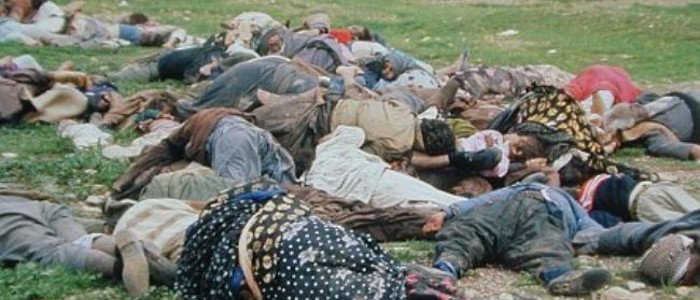
But experts believe that the risks are growing due to advances in technology. The rise of bioengineering and cheap, small-scale lab equipment means a small group of radicals could create something nasty.
Importance of respirator mask fit
Since respirators only work by creating a safe pocket of protected air around your nose and mouth, any leaks or gaps let dangerous air sneak in from the outside.
Which probably makes you less safe than wearing no filter at all, because you might take more risks since you falsely think you’re protected.
But a surprising number of people don’t get the fit right. A CDC study found that 76% of laypeople put their respirator on wrong. A full 22% of people put them on upside down!
The CDC even found that 10% of healthcare workers still had poor mask fit in the months after a professional fitting and test.
It makes a big difference. The same study found that a properly sealed respirator blocked 99.6% of an infectious virus. But a poorly-fitted one only blocked 66.5%.
Fit also affects comfort. In another study, professionals wearing properly-fitted masks ranked their discomfort after a few hours as a low 2.5 out of 10. Very tolerable.
But if not fitted properly, all you’ll want to do is take it off or fidget with it. According to the Center for Infectious Disease Research & Policy: “During the H1N1 pandemic the CDC recommended N95 respirators for all healthcare workers in close contact with flu patients, but many opposed the advice on the basis that respirators are uncomfortable to wear for long periods of time.”
Respirator fit tests
At the minimum, even cheap disposable masks should have a metal strip or wire along one side. You bend this strip around your nasal bridge to create a custom fit.
The mask should cover all of your nose up to the bridge, and down to a bit of a lip around the bottom of your chin.
You can quickly test on your own to see if you have a good seal. The method depends on the mask type.
On disposables, use your fingertips to feel for airflow around the edges as you breathe in. Example video.
On half or full masks, block the input filter(s) with your hands and then suck in — if you’re getting any air, that means it’s sneaking in somewhere. You should also notice the mask sort of cave in as you create a vacuum inside.
Children and those with facial hair can’t use most respirators
Facial hair is a big deal. Any noticeable hair under the mask rim seal will create enough of a gap to be a problem. There’s no official measurement guidelines, but we’d estimate it to become a problem after more than a few day’s worth of stubble. Soul patches are OK, but fu manchus aren’t.
According to the official Colorado wildfire guide, “Most people won’t use the masks correctly and won’t understand the importance of having an airtight seal. For instance, it is impossible to get a good seal on individuals with beards. As a result, the masks will provide little if any protection.”
There are some DIY hacks discussed around the internet, like putting petroleum jelly on your hair so that it can create a seal. The longer the hair, the less likely it will work, but it’s better than going without a mask at all.
Children also have difficulty with proper seals, mostly because there’s no commercial market for child-sized masks. NIOSH does not certify any masks for children.
Some people get away with buying small or extra small masks for children over ~8 years old. But there isn’t any legit data about how effective that is.
For both children and fuzzy faces, disposable and half mask respirators are worthless. You’ll need to get around the problem by using a protective system that does not depend on creating an airtight seal around the face.
Although we’re not comfortable making specific recommendations, we show some child gas masks and facial hair escape hoods below.
Best disposable respirator masks for emergencies
There are a lot of options. Which can be confusing because many of the various options are for specific healthcare or industrial situations, yet aren’t clearly labeled or explained for everyday consumers.
We prefer masks that have some rigidity or heft to them. Although, there are some high quality collapsible models that seem to hold up well, plus they’re easier to store in a glove box or bug out bag.
We really like disposables with exhalation valves, which let your exhaled breath leave the mask through a one-way valve. A mask is worthless if you fidget with it or remove it because it got hot and sticky after 20 minutes. These valves can lower the temperature inside the mask by 15 degrees!
Among the various N/R/P 95/99/100 types, it makes sense to either do N95 for the cheapest and easiest to breathe, or P100s for the best protection. No real point using R99s, etc.
The two main brands are 3M and Honeywell. Both have been providing professional industrial and medical protective equipment for a long time, and we trust their work over lesser-known brands.
We lean a little towards 3M because their product information and ecommerce organization is a lot clearer for consumers. The Honeywell products are not easy to buy individually.
However, some reviews say the Honeywells are a better fit than 3M. We like the idea of the softer material around the edge of the Honeywells that’s intended to create more of a gel-like seal, but haven’t yet tested if it makes a fit difference.
Buy one or two at first to see if you like the fit. If you try one brand and don’t like the sizing, seal, or comfort, switch to the other brand.
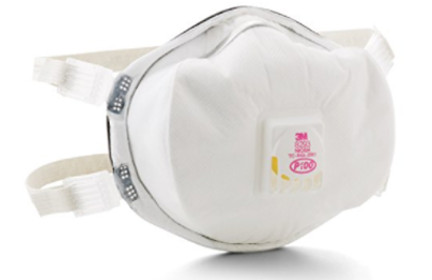
Best disposable:
3M 8293 P100 Disposable Particulate Respirator
Based on our research, the top disposable particulate mask is the 3M 8293 P100 at $13 a piece. It has an exhalation valve, adjustable straps, and a five year shelf-life (compared to three years on other options). We chose the 8293 over the 8233 because it works against oil-based aerosols and over the 8271 because of stronger protection against smoke, arsenic, etc. Official spec sheet.
The Honeywell substitute is the Sperian P100 Saf-T-Fit at $20 each. Honeywell uses colored nose clips for sizes. Red is small, green is M/L, blue is XL.
Among P95 models, we like the 3M 8576 P95 Acid Gas at $40 for a box of 10. Besides normal P95 particulate protection, this mask helps with “nuisance levels” of gases like sulfur dioxide, hydrogen fluoride, chlorine, and bleach. That means it’s not good enough to be government approved for hazardous jobs, but it does make a difference. There’s a different model for Organic Vapors, but since you have to chose one or the other, Acid Gas makes more sense for prepping. Official spec sheet.
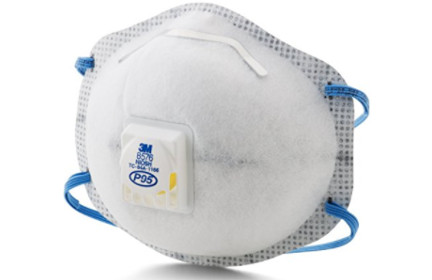
Good middle ground:
3M 8576 P95 Respirator
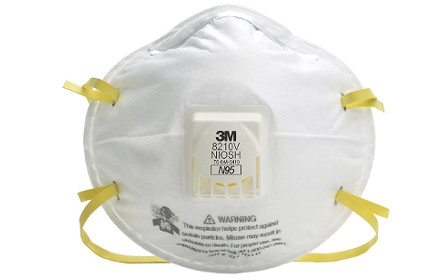
Cheapest acceptable option:
3M 8210V N95 Respirator
The cheapest (yet still acceptable) N95 mask is the 3M 8210V N95 at $20 for a box of 10. Official spec sheet. The “V” is for valve, so this cheap mask still includes an exhalation valve. If you’d rather spend $3 to get a more rigid mask, the step up is the 3M 8511 N95 at $23 for 10.
If you really want a foldable mask that’s easier to store (and don’t mind the sacrifice in protection), the 3M 9211+ N95 is the way to go at $30 per 10.
Best half face respirators and filter cartridges
We think half masks should be much more frequently used by preppers. They are a great option if you don’t want to go full mask but want something more protective and durable than a disposable. Whereas disposables are for particulates and minor levels of vapors, half masks start to handle gases, too.
Plus you’ll look like Bane from Batman and people will avoid you 🙂
The big downside about half masks is the sometimes awkward placement and design of external filters/cartridges. Most of the filters are overly bulky and flimsy, since industrial manufacturers aren’t thinking about prepping scenarios.
Further, some people think, “If I’m going to wear something rigid and bulky on my face, I may as well go full mask and get the eye protection plus much better chemical protection”.
In practice, half masks will provide just as much protection as a full mask in half or more of the emergencies you’re likely to face.
Brands are similar to the disposable category. 3M, Honeywell / Sperian, and MSA are all common. But they all have proprietary filters, so we’re standardizing within the most popular 3M brand.

Industry-tested comfort:
3M 7500 Half Facepiece Respirator
We like the very popular 3M 7500 masks for $20 (before filters). Reviewers love the downward exhalation valve, which keeps your hot breath from fogging up any glasses. A soft silicone face seal is more comfortable and does a better job of creating a proper seal than disposable masks. Model 7501 is small, 7502 is medium, and 7503 is large. Official spec sheet.
If you want to save a little money, go with the $18 3M 6500 rather than the $10 3M 6000. One big reason is the 6500 also has the downward valve, while the 6000 doesn’t. The 6500 also has a quick latch, so you can drop the mask from your mouth without removing all the straps around your head.
Half mask filters and cartridges
Filters typically refer to N/R/P-type particulate filters, while cartridges refer to the organic and gas absorbers.
Unless you specifically buy a kit, most masks don’t come with the necessary filters or cartridges (or they throw in junky freebies). And most half masks require two of whatever filter/cartridge you’re using, one on each cheek.
Pairing with the 3M masks above, we like the 3M 7093C P100 plus Nuisance Gas filter, which is around $25 per pair. It combines the normally separate particulate filter and gas/vapor filters into one relatively low-profile piece that reduces the awkward problems with half masks. Plus the hard exterior shell makes the filters much more durable than the common soft options.
Beyond the normal P100 filter protection, it also protects against lower “nuisance levels” of organic vapors and acidic gases, like carbon dioxide and hydrogen fluoride. That means it has a protective effect but isn’t strong enough to be used daily in toxic industrial settings for NIOSH certification.
A great option for bug out bags and get home bags, the 7500 mask and 7093 filter combo is one of the best possible balances of cost/weight/size versus protection level.
We also like the thoughtful feature that makes it easy to test if your mask is properly sealed around your face at any time and without any other equipment. You just compress the cartridge with your hand and it blocks the intake airways via an internal spring mechanism.

Slim combo for half masks:
3M 7093C Nuisance Gas Filter
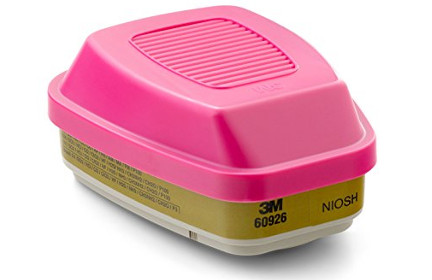
Great for half masks:
3M 60926 Multi Gas Vapor Filter
If you want stronger protection against a wider range of vapors and gases, you have to get bulkier units. The filter sits on top of the chemical cartridge so that the particulates are screened out before hitting the chemical side.
They sell pre-assembled combo units, but they are only available in a hot pink color. The 3M 60926 Cartridge plus P100 Filter is $28 for the pair and rated against certain organic vapors, chlorine, hydrogen chloride, chlorine dioxide, sulfur dioxide, hydrogen sulfide ammonia/methylamine, formaldehyde, and hydrogen fluoride. Official spec sheet.
To avoid the hot pink without masking over it yourself, you essentially have to DIY the filter and cartridge combo. Buy two each of the 3M 603 filter adapter and 3M 501 filter cover, which together create the sandwich housing for the filters. Then buy however many 3M 5P71 P95 filters you want. The filters are basically cloth pieces that you swap in and out of the housing as needed. The two housings and 10 filters will cost around $35.
But you’ll still need to buy the cartridge half of the combo. We like the 3M 6006 at $13 per pair. They protect against the same gases as the 60926 above. Spec sheet.
How to buy a gas mask or full respirator
Be skeptical. Because fear mongering and Doomsday Porn cause many people to impulsively buy gas masks, there are tons of exploitive scammers and just plain wrong social media info.
Which leads to countless listings on Amazon, eBay, etc. that label a mask or filter as “CBRN/NBC!” when it’s clearly a cheap airsoft mask.
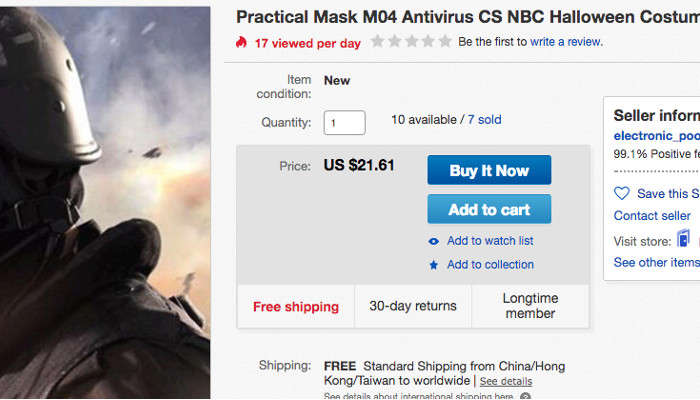
We strongly recommend you only buy new products in unopened factory-sealed bags. There is a lot of questionable surplus gear in the world of prepping in general, but surplus respirators in particular have a bad reputation.
Many preppers report buying surplus products that are expired, have defective seals, manufacturing stickers that were removed to hide the true dates, sellers flat out lying about dates, outdated designs, and even antiquated cartridges that use harmful elements for chemical absorption.
Avoid clones from countries like Lithuania, Russia, or China.
If it seems to good to be true or lacks coherent info, don’t buy it. If it arrives not as described, return it.
Be careful with marketing tricks, since many products will use words like “emergency response” or “tactical preparedness” to make them seem stronger than they are.
If it doesn’t say NIOSH certified for CBRN or NBC, don’t buy it.
Avoid anything you can’t find reliable information about directly from the manufacturer. No manufacturer website or info? Don’t buy it. That’s why we include the official spec sheet links in this article.
Sizing can be tricky. In general, most major manufacturers say that the medium size covers 70-80% of adults. Large sizes are typically for those that need a size 8 ¼ hat or above.
Availability and clear product info can be tricky. Especially since much of the military grade gas mask equipment is sold through distributors, and not normally to civilians, so it’s ripe for a fraudster to put up a bogus Amazon or eBay listing.
3M and Honeywell have an advantage because they are for industrial customers, so their products are much easier to find in new condition.
Since trust is such an issue in this segment, we tend to prefer paying more to buy from a reputable distributor like Grainger. For example, a filter recommended below is $100 from Grainger but $60 from a small unknown shop. But at least you’ll know it’s authentic and won’t expire soon.
NBC vs. CBRN gas masks
There is not much of a practical difference between these two ratings. For the vast majority of circumstances, NBC is fine. CBRN is technically better. It’s your personal choice whether the difference matters to you.
NBC was the standard until the early 2000’s. The 9/11 attacks created a new wave of fear and government action (read: spending!) — particularly around terrorist threats. People became concerned about scary new things like “dirty bombs”, “backpack nukes”, and industrial sabotage at local nuclear power plants.
That’s when the NBC rating evolved into the CBRN rating, which is NBC + Radiation.
“Wait, isn’t radiation already covered by the Nuclear portion of the NBC rating?”
Yes and no. The best example is the difference between a conventional nuke and a dirty bomb. Conventional nukes and their radiation have been well understood for 60 years. So when they created the NBC rating, the N was testing against the type, density, and duration of radiation from conventional nukes.
A normal nuke creates the radiation during and after the explosion. But dirty bombs function very differently — a conventional explosive, like dynamite, is wrapped with material that is already radioactive. Kind of like a shrapnel grenade, but with radioactive waste. The explosion spews that radiation in a local area.
Since the radioactive material might be sitting around for a while as it waits to be dispersed, rather than being created “on site” at the moment of explosion, the isotopes used in dirty bombs tend to be longer lasting (which also means they’re weaker).
So CBRN protective equipment has to be able to withstand radiation that acts differently than traditional fallout. Which is why some of the mask materials used have to be impenetrable, like butyl rubber rather than silicone, so that it can handle exposure for longer periods of time without breaking down.
How we picked the best gas mask for sale
Technically full face respirators, gas masks get beyond the normal industrial and healthcare brands and includes military or emergency brands. Top companies (in no particular order) are MSA, Mestel, Honeywell / Sperian / North, 3M, Scott, Draeger, and Avon.
If you’re going to invest in and wear a giant mask, make sure it’s at least certified to protect you against the full NBC threat spectrum (Nuclear, Biological, and Chemical).
Because militaries like to use common standards across products, most of the good masks use NATO-standard 40mm threaded filter mounts. That makes it a lot easier to buy filters now and potentially find other ones after SHTF.
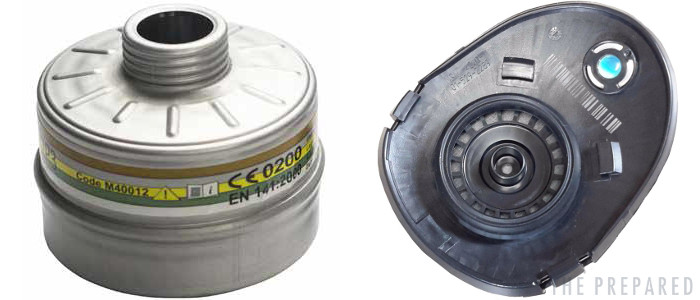
So we tried to avoid proprietary filters. There are a few good masks with proprietary nonstandard filters (namely the Avon and Scott models), so we do consider them, even though it’s a negative quality.
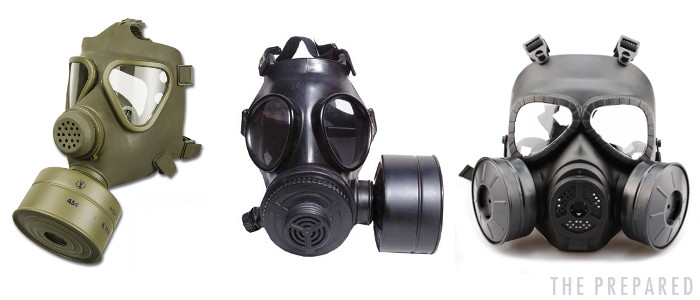
Many full masks have the benefit of multiple filter ports. We like the masks with three options, so you have more flexibility to run a cartridge on either cheek or straight down from your chin. You can switch depending on which side you shoulder a firearm. Sometimes you can run multiple filters at once, which makes it much easier to breathe (less resistance) and can balance the weight from side to side.
Lastly, although it’s unlikely you’ll be hot-swapping filters in the field, two filters makes it easier to swap one filter while still breathing through another. The military found in practice that even with training, soldiers in high-stress situations were fumbling to connect their filter while holding their breath.
Vision is handled through a single large visor or two individual bugeye holes. A bugeye mask is a little easier to fold in half for storage. But we think the superior field of view in the single visor masks is worth the tradeoff. Plus, new materials like polyurethane lenses mean the full visors are almost as flexible as the bugeye versions.
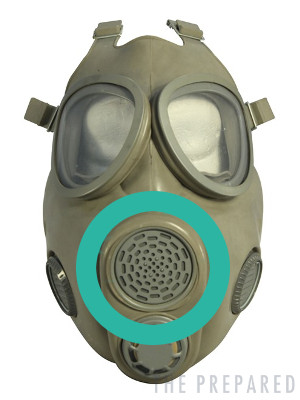
Some masks have a speaking diaphragm / voice emitter that helps amp your voice outside the mask. Military-style masks have optional accessories for electronic communication hookups. While nice, we didn’t focus on that feature for the same reason as the drinking tube.
Common gas mask accessories
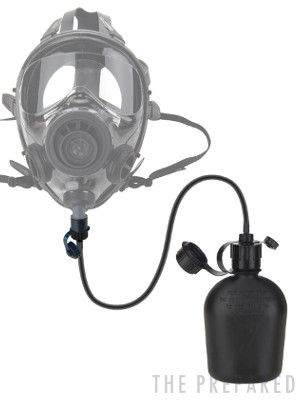
You can’t wear normal eyeglasses inside a full face mask because the side bars break the seal near your temples. Many of the top masks offer eyeglass inserts, which have stubby side supports.
Since you can’t wear sunglasses either, some masks have outserts that clip on to the outside of the visor. There are basic polarized versions and blue, red, or yellow for filtering specific light. Others offer stick-on films, similar to a phone screen protector.
Some masks can pair with a hood. It hugs tightly around the edge of your face mask, sort of like a poncho, and protects the rest of your head, neck, and shoulders from chemical and fallout radiation exposure.
Best CBRN NBC gas masks when SHTF
While it seems like there are lots of different military grade gas masks, there are actually only a handful we would trust with our lives.
The majority of masks found online are disqualified for being surplus, outdated, impractical, or dangerous low-quality clones. For example, too many preppers are depending on 50-year-old Soviet technology or filters made with asbestos or chromium!
There aren’t clear winners and losers among the qualified options. It might come down to how well one model fits on your face, particular accessories, or simple price and availability.

Best gas mask:
Mestel SGE 400/3 Gas Mask
Mestel SGE 400/3 and 400/3 BB. There’s an important distinction between these popular models, and unfortunately we’ve seen many other prepper sites get it wrong. The $270 (includes filter) SGE 400/3 base model is NBC rated. The $240 SGE 400/3 BB model is CBRN certified due to the butyl rubber face seal, an impermeable material that won’t break down from or absorb particularly nasty stuff like mustard gas. The cheaper NBC model is fine for most people and circumstances, but whether or not the difference matters is up to you. Each model has multiple 40mm NATO filter mounts. Great field of view. Options for eyeglass frames, protective lens stickers, drinking tube/canteen, and an integrated PVC hood. Assembled in USA. Official brochure.
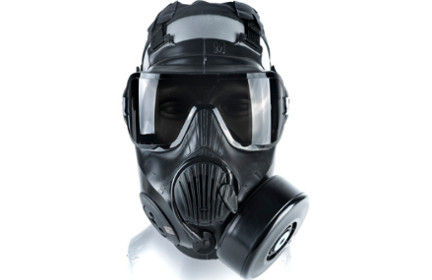
Avon C50 Gas Mask
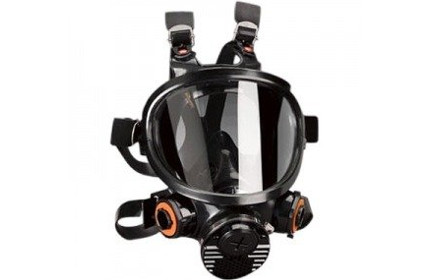
3M 7800S Full Facepiece Mask
Avon C50 CBRN. $450. The civilian and law enforcement version of the new US military M50 gas mask. Very well reviewed and popular. You get what you pay for. While the military versions use a cool proprietary filter, the C50 uses the preferred 40mm mount on both cheeks. Distortion-free, flexible lens that won’t yellow. Nice range of accessories, like sun-blocking visor outserts. If you want the accessories, check out the $682 First Responder Kit. Official specs.
3M 7800S First Responder and 7800B CBRN. Similar story to the Mestels. The $580 3M 7800B is CBRN certified (due to the butyl rubber seals), while the “civilian” $512 3M 7800S is not. Although the 7800S is technically not NBC or CBRN certified, since the 7800 masks are the only 3M masks that can use third party 40mm filters, you could pair any 40mm NBC filter with the 7800S and be fine in almost all NBC circumstances. We particularly included this mask because some people prefer more commonly found industrial equipment rather than the military gear. Plus it (usually) comes with 3M 701 adapters that turn 40mm threads into bayonet mounts — so you can run both CBRN filters and the industrial 3M cartridges you already have around for your half mask! 7800B spec sheet. 7800S spec sheet. Chemical protections.
Bonus accessory for half and full mask filters
3M 701 40mm Filter Adapter
Many people will end up with some half masks, perhaps to keep in their bug out bags, and also some full masks to keep at home for larger NBC/CBRN issues.
3M sells an adapter that screws into 40mm filter ports, allowing you to mount the typical industrial-style bayonet cartridges found in most half masks, like the 3M 7093 and 60926 filters we recommend above.
That’s a great addition to your kit, regardless of which 40mm gas mask you use, because it’s an easy way to create redundancy and get more bang for your buck.
You can run standard 40mm NBC/CBRN filters or run the smaller 3M bayonet cartridges for things like wildfire smoke or riot control agents. Or perhaps you use the NBC filters in the 2-3 days after a nuclear incident, but then your filter supplies run out and you can switch over to the bayonet cartridges.
Best budget gas masks
Understand that in all of these budget cases, you’re buying surplus. They might label it as “new in bag”, but they were still handed out to civilians (who are then reselling them at some unknown time later) or sat on a shelf for years.
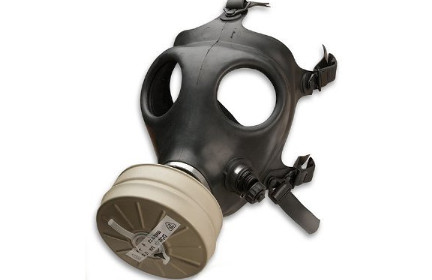
Israeli 4A1 Civilian Gas Mask
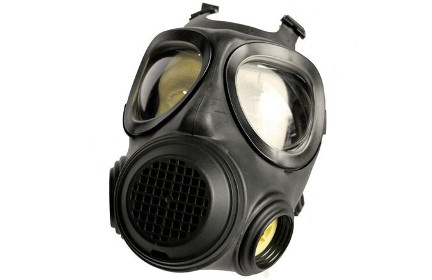
Forsheda A4 Gas Mask
Israeli Civilian Gas Mask (aka Shalon 4A1). $157 including one NBC filter. One size fits most. Civilian version of the Israeli M15. Israel has been handing these out to every citizen through their post office network. Basic but dependable quality. Tiny voice emitter. Note that almost every listing for this product on Amazon, eBay, etc. includes the tan colored filter, which is expired, even though the listings won’t admit it. So buy the mask and a new third party 40mm filter.
Forsheda A4 NBC. $100. 40mm, but can only mount on left cheek. Bugeyes, but relatively better vision than other bugeye models. Lightweight. Voice emitter is subpar. Civilian version of the F2 mask used by the Swedish military and rescue services since 1997.
Avon FM12 (sometimes called CT12). Considered one of the most widely used respirators, especially in the 2000’s. Good if you can find it new. If you insist on buying surplus, this is a good choice and can be found for under $100. 40mm mounts, can run on either cheek. Reviewers consider the FM12 more comfortable than the S10 it replaced. Official page.
Commonly found but usually not worth it
MSA Advantage 1000 CBA/RCA. $324. Not NBC — CBA/RCA refers to threats like Riot Control, a lessor tier of protection. Some preppers argue that if you pair it with an NBC filter, you’re fine. That may be the case, but we don’t think it’s worth taking the chance, especially for the same cost. Uses proprietary filters, but has an adapter for 40mm mounts. The $290 Advantage 4000 uses 40mm.
MSA Millennium CBRN. Around $600. The first mask officially approved for the CBRN standard back in the early 2000’s, but seems outdated at this point. Decent reviews, but is often considered to be less of a good deal compared to the SGE or Avons. Replaced the older (but still found among preppers) MSA MCU-2/P, which you should also skip. 40mm, but MSA mounting info is confusing. Official page.
Honeywell Sperian Survivair Opti-Fit CBRN. $250. Given Honeywell is an employee safety company, rather than a military/LE manufacturer, it makes sense that this mask seems to be built more for industrial use than emergencies. For example, the unusually large face visor is not flexible, and we don’t like some of the design choices. 40mm mounts. Made in USA. Official page.
Scott GSR (General Service Respirator) and Scott FRR (First Responder Respirator). Difficult to buy online. The GSR is the current British military mask, replacing the old Avon S10. Many soldiers prefer the old S10 and think the Avon M50 should’ve been chosen, but the GSR won because of lower cost. The US military ended up choosing the M50 (the C50 civilian equivalent recommended above). The GSR uses proprietary and hard to find filters. The civilian FRR uses 40mm mounts. Official page.
Russian GP-5 (sometimes Polish). Just… don’t. Unless you’re a techno raver airsoft cosplayer or insist on being “that” prepper.
Best CBRN gas mask filters

Best for gas masks:
Mestel 40mm CBRN Filter
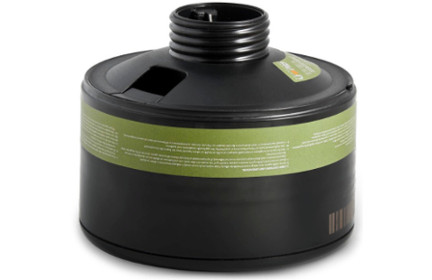
Best for gas masks:
Avon CF50 CBRN Filter
Mestel CBRN. $40 each. 40mm. P100 filter. A2B2E2K2P3. Protects against all known/practical biological and chemical agents, such as chlorine, hydrogen cyanide, organic and inorganic acids, anthrax, sarin, mustard, and riot control agents. Lab results (starts on page 31).
Avon CBRNCF50. $70 on Botach or $112 on Grainger. Although Avon offers a few CBRN filters, the CF50 is the most easily found. We wish we could get access to the MILCF50 or CBRNF12CE filters for their longer shelf life and threat protection, but they’re not available to civilians. You can buy the CTCF50 filter, which is a lower profile casing that hugs the cheek by conforming to the Avon C50 mask, although loses the CBRN protection, dropping down to standard particulates, bacteria/virus, and riot control agents. Lab results.
3M FR-15 CBRN. A four pack is available for $255 from Envirosaftey or $510 on Grainger. 40mm. P100 filter. Protects against all known/practical biological and chemical agents. Lab results.
It can get really confusing if you try to understand all of the specific threats and their acronyms and color codes. Stick with the basic umbrella certifications, which combine a bunch of threats into one label, like CBRN and NBC certifications.
Quick reminder that CBRN is your highest level of protection, followed closely by NBC, then CBA/RCA (Chemical Blowing Agents / Riot Control Agents).
Once you go below those groupings of threats (e.g. “riot control”), then you start to see labels for protecting against X specific chemical or Y specific vapor. You’ll sometimes see acronyms like OV (Organic Vapors) and Hg (Mercury), especially in the industrial safety products.
Many European companies standardize with ABEK, which results in seeing CBRN filters labeled something like A2B2E2K2P3 or ABEK2-P3 (the same thing) with matching color codes. Each letter represents a threat (like A for organic gases) and the number is the protection level (A2 > A1). P3 is the international equivalent of a P100 filter.
Sometimes you’ll see reference to labels like “Cap 1”. They refer to Capacity, which represents the length of time it was tested against threats. Cap 1 is the lowest level at 15 minutes. That doesn’t mean it stops working at 15 minutes in all scenarios. Rather, it’s the least amount of time for the most aggressive threat. Other threats could be defeated for 24 hours on a Cap 1 filter.
To keep it simple, look for filters that are CBRN or NBC rated and preferably have ABEK printed on the cartridge (so you know all the boxes are checked).
Remember, be skeptical of sellers and the manufactured / expiration dates. If you receive a filter outside of properly sealed wrapping, send it back — the plastic caps directly over the 40mm mount aren’t enough, it needs to be fully enclosed to get the best shelf life.
Although many manufacturers will claim five year expirations, in practice you’re likely fine out to 10 years when properly wrapped and stored.
Most NBC filters last about eight hours, but it really depends on what you’re exposed to, for how long, humidity, etc.
Alternatives and emergency escape hoods
For children, fuzzy faces, or just if you’re curious: Here’s some alternatives beyond those three main respirator types. Note we have not used these before, are not making any recommendations, and would still suggest you lean towards the proper respirators above.
Child gas masks
Keep in mind that a normal respirator, which works by creating a vacuum seal around your face, just isn’t going to work well with kids. Russia, Israel, and Britain have made smaller child sizes of their civilian gas masks in war time, which might work well for kids ages 8-14. For the British S10, look for size 4. The Russian models are labeled as either small GP-5 or PDF-D size 1 or 2. The Israeli version is usually just labeled “for kids” but is technically the Shalon 10A1.
For smaller children and infants, you could use a hood version that creates a bubble by securing around their neck or their entire body. Some use a powered air system, since smaller children often don’t have the lung strength to draw air in through NBC filters. In Israel they use the Bardas hood system for kids over 2, and the Shmartaf for infants over 3 months.
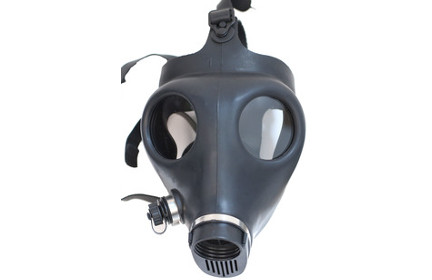
Israeli Youth Gas Mask
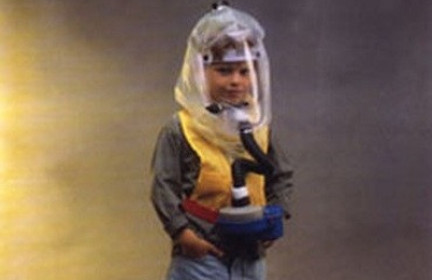
Shalon Bardas Children’s Gas Mask Hood
Facial hair gas masks / CBRN escape hoods
Since you can’t create a proper seal around your face, you have to seal around your neck or head. These single-use CBRN hoods are kept in compact containers in the trunks of police cars, fire trucks, etc. Throw them over your head, get a good seal, and escape.
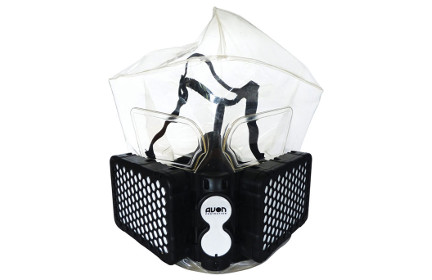
Avon NH15 CBRN Escape Hood

Honeywell Emergency Escape CBRN Hood
Pollution masks
There are a bunch of “anti pollution masks”. They aren’t meant for emergencies and don’t meet NIOSH standards, but could be a decent alternative for your daily commute in polluted areas.
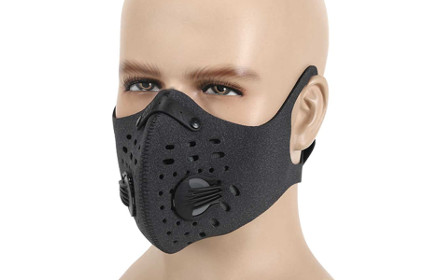
Powzdi Dust Mask
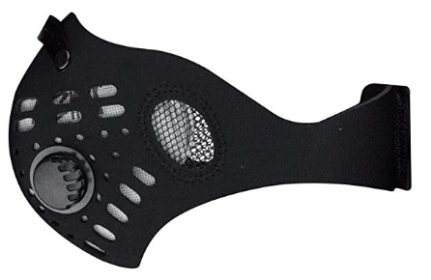
RZ M1 Dust and Pollution Mask
Fire escape hoods
These are single-use packages meant to be kept in a drawer or closet near wherever you spend the most time. If you’re sitting at your work desk and fire breaks out, you crack open the pouch and slip on the hood so that it closes down around your neck. You then have 15-30 minutes to escape.
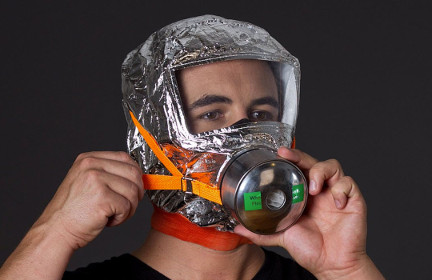
Firemask FM60
